Numerical Study on Interfacial Structure and Mixing Characteristics in Converter Based on CLSVOF Method
Abstract
1. Introduction
2. Materials and Methods
2.1. Geometric Models
2.2. Control Equations and Boundary Conditions
- (1)
- Oxygen and argon are the constant physical incompressible Newtonian fluid.
- (2)
- Temperature and chemical reactions in the molten bath are not considered.
- (3)
- The standard wall function is adopted for the near-wall treatment in the turbulence model with a no-slip wall boundary.
2.2.1. Basic Governing Equations
2.2.2. Boundary Conditions
2.2.3. Solution Method
3. Results and Discussion
3.1. Model Validation
3.2. Subsection
3.3. Criteria of Mixing Time
3.4. Effect of Bottom-Blowing Flow on Mixing Behavior
3.5. Effect of Bottom-Blowing Mode on Mixing Behavior
4. Conclusions
- (1)
- The VOF and the CLSVOF methods are compared to track the gas-bath interface fluctuation with the same number and quality of grids. The CLSVOF method has a better tracking accuracy of the complex gas-bath interface morphology during the gas column rising process than the VOF method.
- (2)
- By increasing the bottom-blowing flow of argon from 0.252 kg/s to 0.379 kg/s, the maximum velocity in the molten bath gradually increases up to 2.763 m/s. Moreover, the mixing times are gradually shortened, with the mixing time reduced to just 66 s when the bottom-blowing flow rate rises to 0.379 kg/s.
- (3)
- The most optimal arrangement of bottom-blowing modes should be Dtuy,1/D2 = 0.19, Dtuy,2/D2 = 0.33. However, if the outer bottom element is too far away from the axis, defects and the overlap of gas columns will reduce the lifting force.
Author Contributions
Funding
Conflicts of Interest
References
- Zhu, M.Y.; Lou, W.T.; Wang, W.L. Research Progress of Numerical Simulation in Steelmaking and Continuous Casting Processes. Acta Metall. Sin. 2018, 54, 131–150. [Google Scholar]
- Lai, Z.Y.; Xie, Z.; Zhong, L.C. Influence of Bottom Tuyere Configuration on Bath Stirring in a Top and Bottom Combined Blown Converter. ISIJ Int. 2008, 48, 793–798. [Google Scholar] [CrossRef]
- Choudhary, S.K.; Ajmani, S.K. Evaluation of bottom stirring system in BOF steelmaking vessel using cold model study and thermodynamic analysis. IEIJ Int. 2006, 46, 1171–1176. [Google Scholar] [CrossRef]
- Olivares, O.; Elias, A.; Sánchez, R.; Díaz-Cruz, M.; Morales, R.D. Physical and mathematical models of gas-liquid fluid dynamics in LD converters. Steel Res. 2002, 73, 44–51. [Google Scholar] [CrossRef]
- Ajmani, S.K.; Chatterjee, A. Cold model studies of mixing and mass transfer in steelmaking vessels. Ironmak. Steelmak. 2005, 32, 515–527. [Google Scholar] [CrossRef]
- Li, Y.; Lou, W.T.; Zhu, M.Y. Numerical simulation of gas and liquid flow in steelmaking converter with top and bottom combined blowing. Ironmak. Steelmak. 2013, 40, 505–514. [Google Scholar] [CrossRef]
- Odenthal, H.J.; Falkenreck, U.; Schlüter, J. CFD Simulation of Multiphase Melt Flows in Steelmaking Converters. In Proceedings of the European Conf. on Computational Fluid Dynamics (ECCOMAS CFD), Egmond aan Zee, The Netherlands, 5–8 September 2006; pp. 1–21. [Google Scholar]
- Luomala, M.J.; Fabritius, T.M.; Härkki, J.J. The effect of bottom nozzle configuration on the bath behavior in the BOF. ISIJ Int. 2004, 44, 809–816. [Google Scholar] [CrossRef]
- Sun, J.K.; Zhang, J.S.; Lin, W.H.; Feng, X.M.; Liu, Q. Effect of bottom blowing mode on fluid flow and mixing behavior in converter. Metals 2022, 12, 117. [Google Scholar] [CrossRef]
- Zarragoicoechea, G.J.; Kuz, V.A. van der Waals equation of state for a fluid in a nanopore. Phys. Rev. E 2002, 65, 021110. [Google Scholar] [CrossRef]
- Christian, T. A new equation of state for real gases developed into the framework of Bader’s Theory. Theor. Chem. Acc. 2018, 137, 93. [Google Scholar]
- Odenthal, H.; Kempken, J.; Schluter, J.; Emling, W.H. Advantageous numerical simulation of the converter blowing process. Iron Steel Technol. 2007, 4, 71–89. [Google Scholar]
- Zhang, J.S.; Lou, W.T.; Shao, P.; Zhu, M.Y. Mathematical Simulation of Impact Cavity and Gas–Liquid Two-Phase Flow in Top–Bottom Blown Converter with Eulerian-Multifluid VOF Model. Metall. Mate. Trans. B 2022, 53, 3585–3601. [Google Scholar] [CrossRef]
- Gu, Z.H.; Wang, T.H.; Wu, T.C.; Li, Y.L. Numerical Simulation on Partially Liquid-Filled Sloshing with Baffle under Different Density Ratios by the CLSVOF/IB Method. China Ocean. Eng. 2022, 36, 922–932. [Google Scholar] [CrossRef]
- Yu, C.H.; Wu, T.C.; An, R.D.; Li, Y.L. Numerical simulation for liquid sloshing with baffle by the CLSVOF/IB method. Ocean. Eng. 2022, 258, 111732. [Google Scholar] [CrossRef]
- Griebel, M.; Klitz, M. CLSVOF as a fast and mass-conserving extension of the level-set method for the simulation of two-phase flow problems. Numer. Heat. Transf. Part B 2017, 71, 1–36. [Google Scholar] [CrossRef]
- Hirt, C.W.; Nichols, B.D. Volume of fluid (VOF) method for the dynamics of free boundaries. J. Comput. Phys. 1981, 39, 201–225. [Google Scholar] [CrossRef]
- Molin, B.; Remy, F.; Audiffren, C.; Marcer, R. Experimental and numerical study of liquid sloshing in a rectangular tank with three fluids: OnePetro. In Proceedings of the 22nd International Offshore and Polar Engineering Conference ISOPE, Rhodes, Greece, 17–22 June 2012. [Google Scholar]
- Lu, Y.J.; Chai, S.H. CFD Verification of Engineering Options for Mitigating Liquid Sloshing in Topside Vessels on a Floating Production Facility. SPE Proj. Facil. Constr. 2010, 5, 113–120. [Google Scholar] [CrossRef]
- Osher, S.; Sethian, J.A. Fronts propagating with curvature-dependent speed: Algorithms based on Hamilton-Jacobi formulations. J. Comput. Phys. 1988, 79, 12–49. [Google Scholar] [CrossRef]
- Olsson, E.; Kreiss, G. A conservative level set method for two phase flow. J. Comput. Phys. 2005, 210, 225–246. [Google Scholar] [CrossRef]
- Olsson, E.; Kreiss, G.; Zahedi, S. A conservative level set method for two phase flow II. J. Comput. Phys. 2007, 225, 785–807. [Google Scholar] [CrossRef]
- Liu, F.S.; Xu, Y.; Li, Y.K. A coupled level-set and volume-of-fluid method for simulating axi-symmetric incompressible two-phase flows. Appl. Math. Comput. 2017, 293, 112–130. [Google Scholar] [CrossRef]
- Son, G.H.; Hur, N. A coupled level set and volume-of-fluid method for the buoyancy-driven motion of fluid particles. Numer. Heat. Transf. Part B 2002, 42, 523–542. [Google Scholar] [CrossRef]
- Sussman, M.; Puckett, E.G. A Coupled Level Set and Volume-of-Fluid Method for Computing 3D and Axisymmetric Incompressible Two-Phase Flows. J. Comput. Phys. 2000, 162, 301–337. [Google Scholar] [CrossRef]
- Liu, D.; Tang, W.; Wang, J.; Xue, H.; Wang, K. Modelling of liquid sloshing using CLSVOF method and very large eddy simulation. Ocean. Eng. 2017, 129, 160–176. [Google Scholar] [CrossRef]
- Eyvazian, A.; Hamouda, A.; Tarlochan, F.; Derazkola, H.A.; Khodabakhshi, F. Simulation and experimental study of underwater dissimilar friction-stir welding between aluminium and steel. J. Mater. Res. Technol. 2020, 9, 3767–3781. [Google Scholar] [CrossRef]
- Bhushan, S.; Fajri, O.E.E.; Hubbard, G.; Chambers, B.; Kees, C. Assessment of Numerical Methods for Plunging Breaking Wave Predictions. J. Mar. Sci. Eng. 2021, 9, 264. [Google Scholar] [CrossRef]
- Yu, C.H.; Wen, H.L.; Gu, Z.H.; An, R.D. Numerical simulation of dam-break flow impacting a stationary obstacle by a CLSVOF/IB method. Commun. Nonlinear Sci. Numer. Simul. 2019, 79, 104934. [Google Scholar] [CrossRef]
- Bahreini, M.; Derakhshandeh, J.F.; Ramiar, A.; Dabirian, E. Numerical study on multiple bubbles condensation in subcooled boiling flow based on CLSVOF method. Int. J. Therm. Sci. 2021, 170, 107121. [Google Scholar] [CrossRef]
- Yang, Z.; Yang, L.; Cheng, T.; Chen, F.; Guo, Y. Fluid Flow Characteristic of EAF Molten Steel with Different Bottom-Blowing Gas Flow Rate Distributions. ISIJ Int. 2020, 60, 1957–1967. [Google Scholar] [CrossRef]
- Wang, Y.; Cao, L.; Cheng, Z.; Blanpain, B.; Guo, M. Mathematical methodology and metallurgical application of turbulence modelling: A review. Metals 2021, 11, 1297. [Google Scholar] [CrossRef]
- Yao, L.J.; Zhu, R.; Dong, K.; Wei, G.S.; Zhao, F.; Tang, Y.X. Influence of the non-uniform bottom blowing gas supply mode on the dynamic conditions of molten pool during the converter steelmaking process. Ironmak. Steelmak. 2021, 48, 180–190. [Google Scholar] [CrossRef]
- Zhou, X.; Ersson, M.; Zhong, L.; Yu, J.; Jönsson, P. Mathematical and physical simulation of a top blown converter. Steel Res. Int. 2014, 85, 273–281. [Google Scholar] [CrossRef]
- Launder, B.E.; Spalding, D.B. PAPER 8-The Numerical Computation of Turbulent Flow. In Numerical Prediction of Flow, Heat Transfer, Turbulence and Combustion; Patankar, S.V., Pollard, A., Eds.; Elsevier: Pergamon, America, 1983; pp. 96–116. [Google Scholar]
- Chen, M. Water Model Study on a 210 t Top–Bottom Combined Blown Converter. Master’s Thesis, Wuhan University of Science and Technology, Wuhan, China, 2011. [Google Scholar]
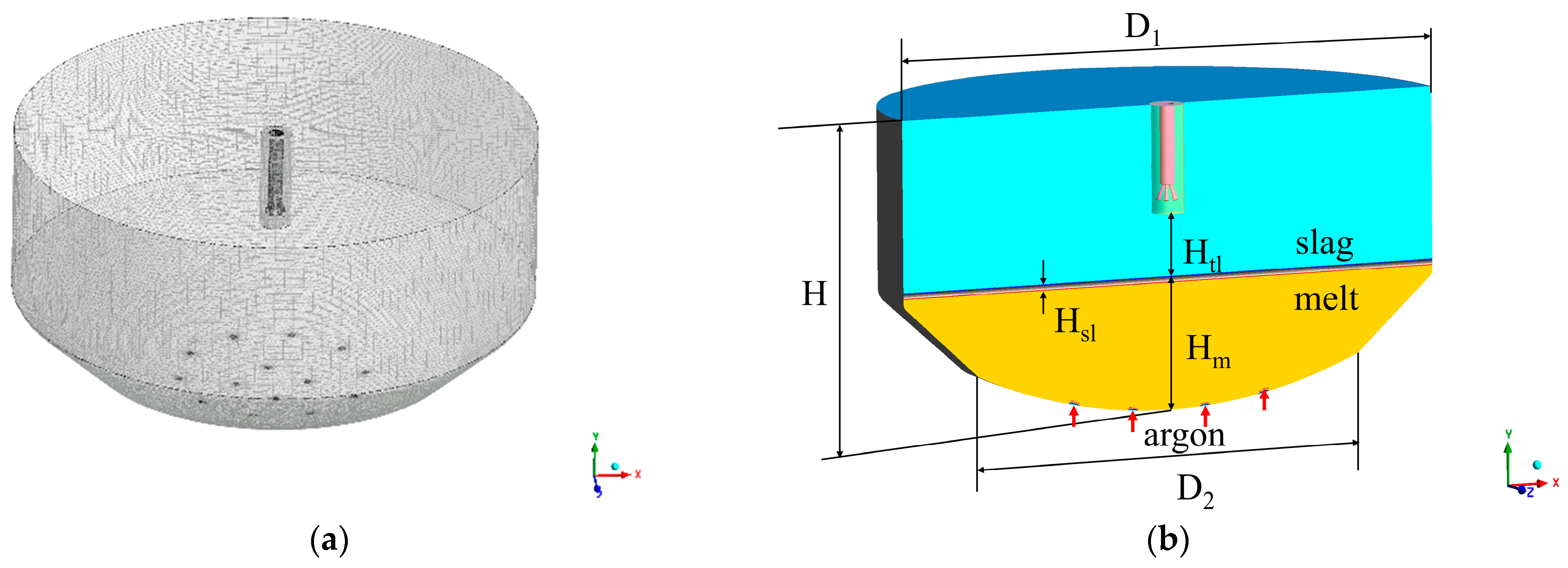
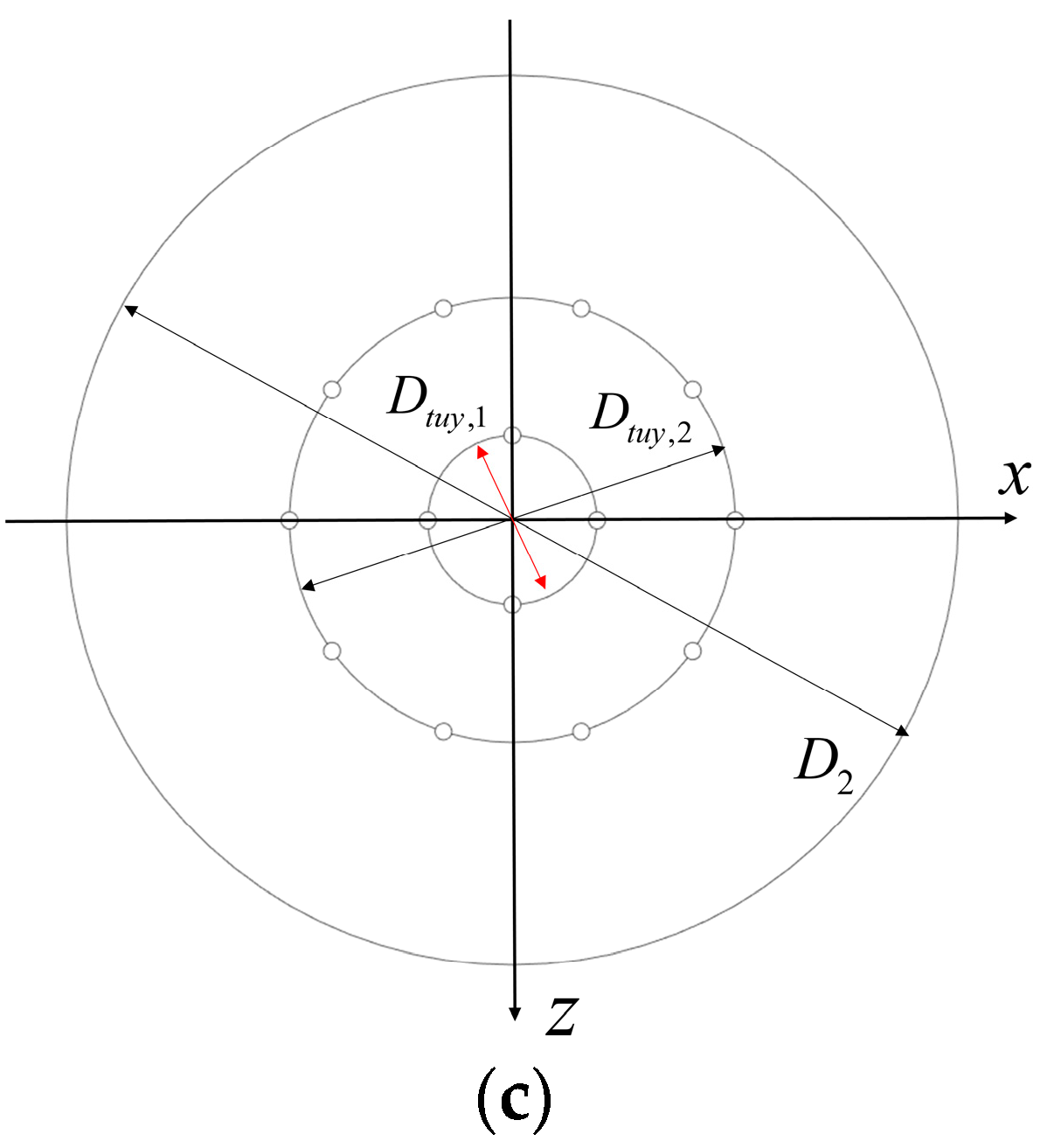
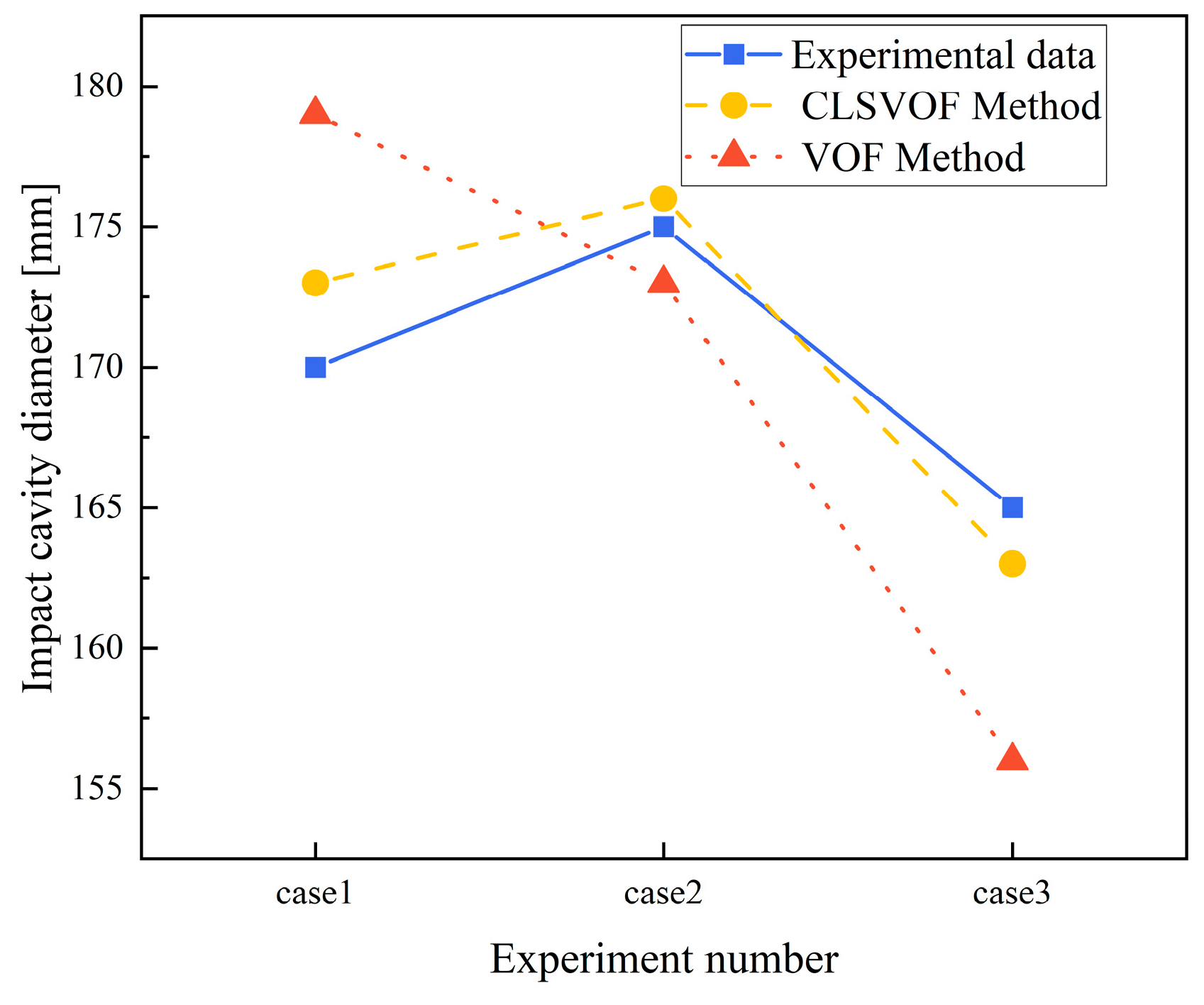


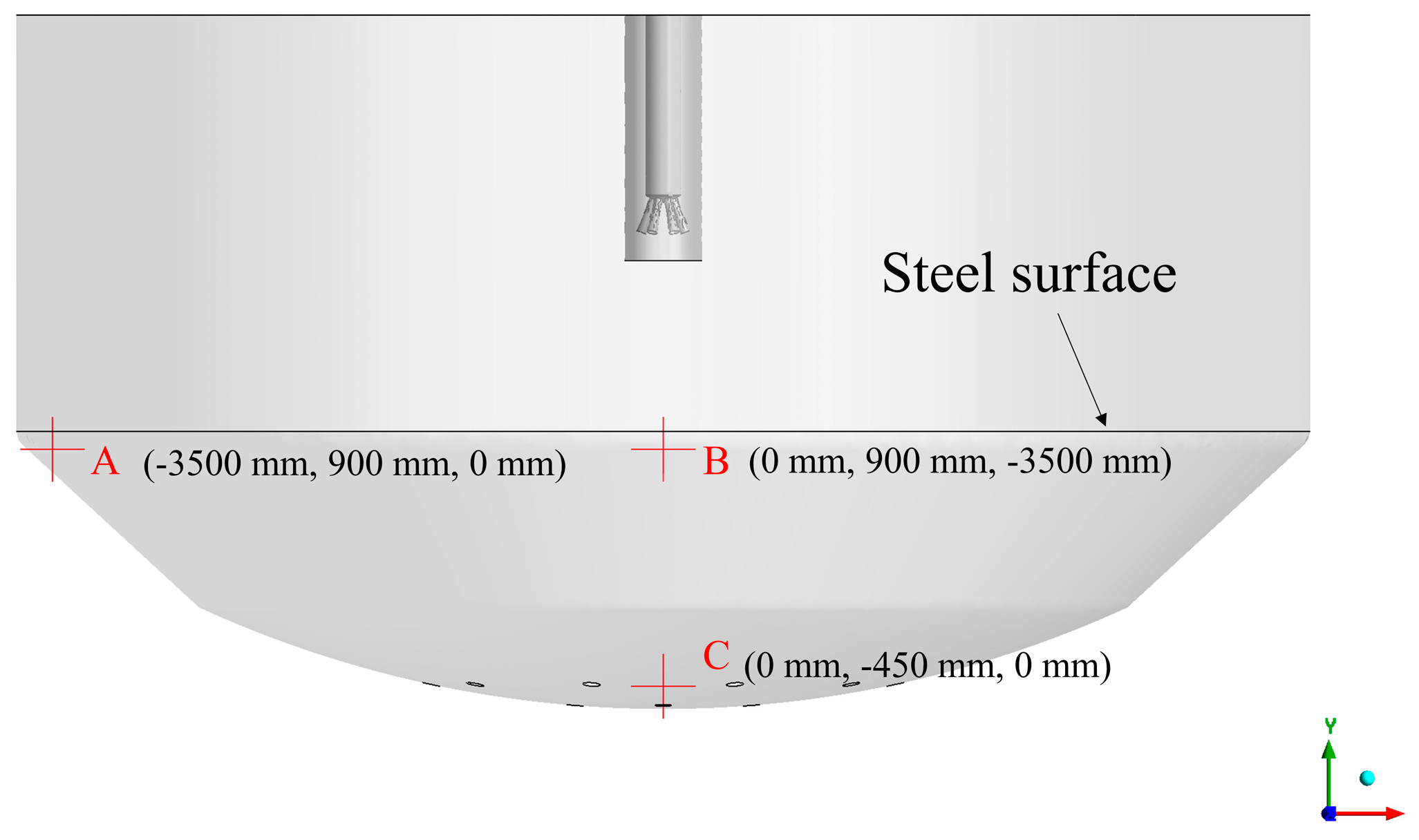
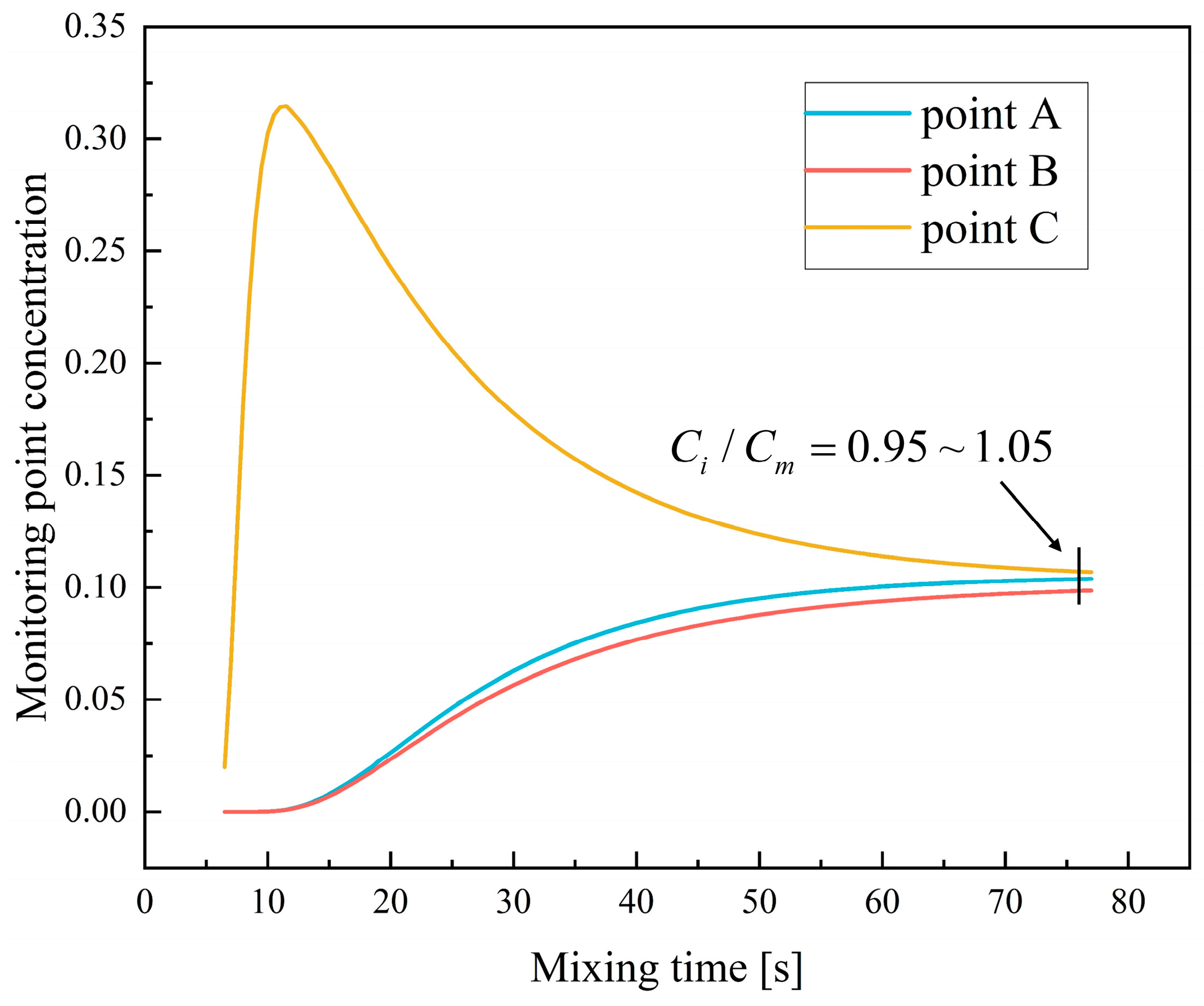
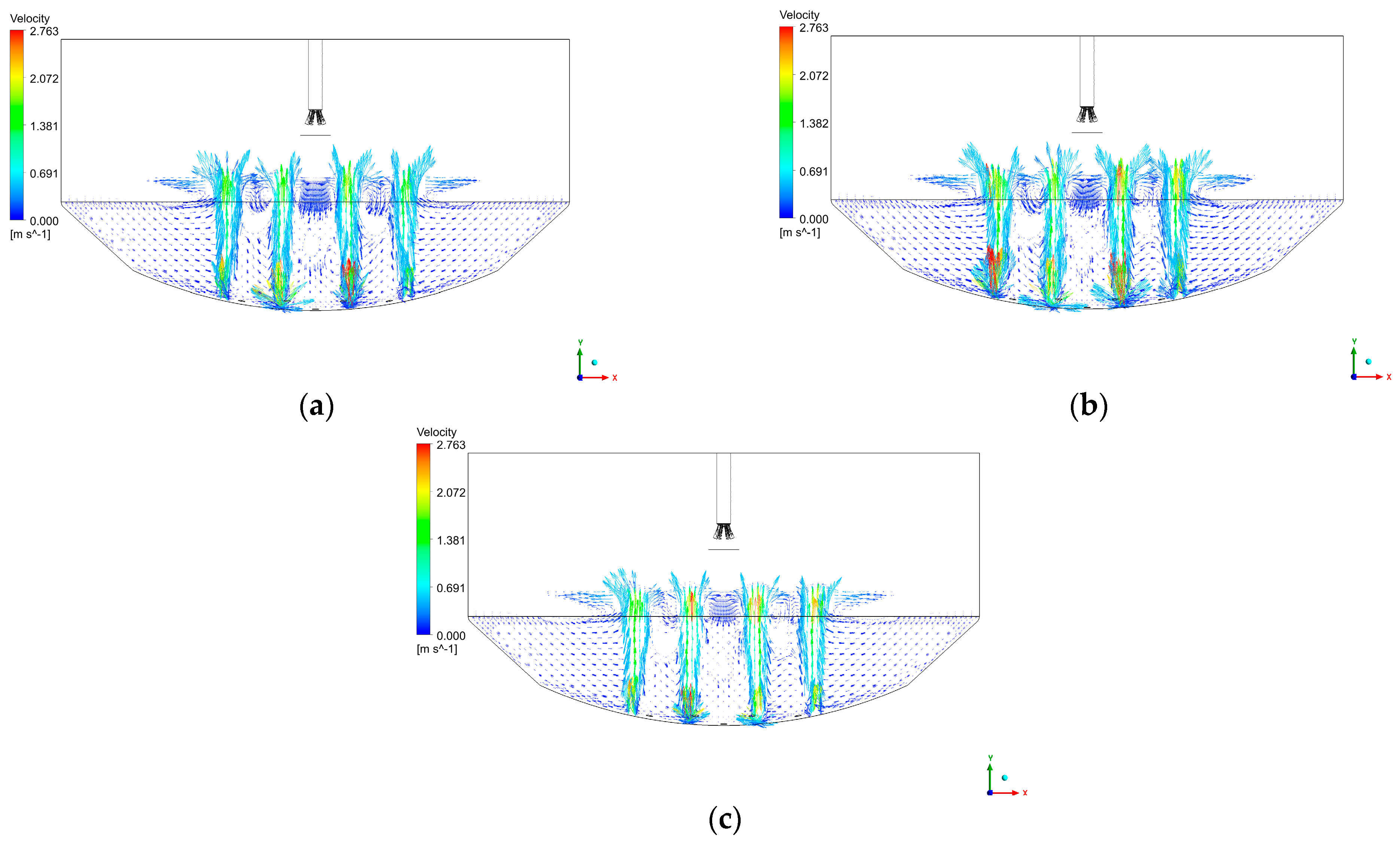
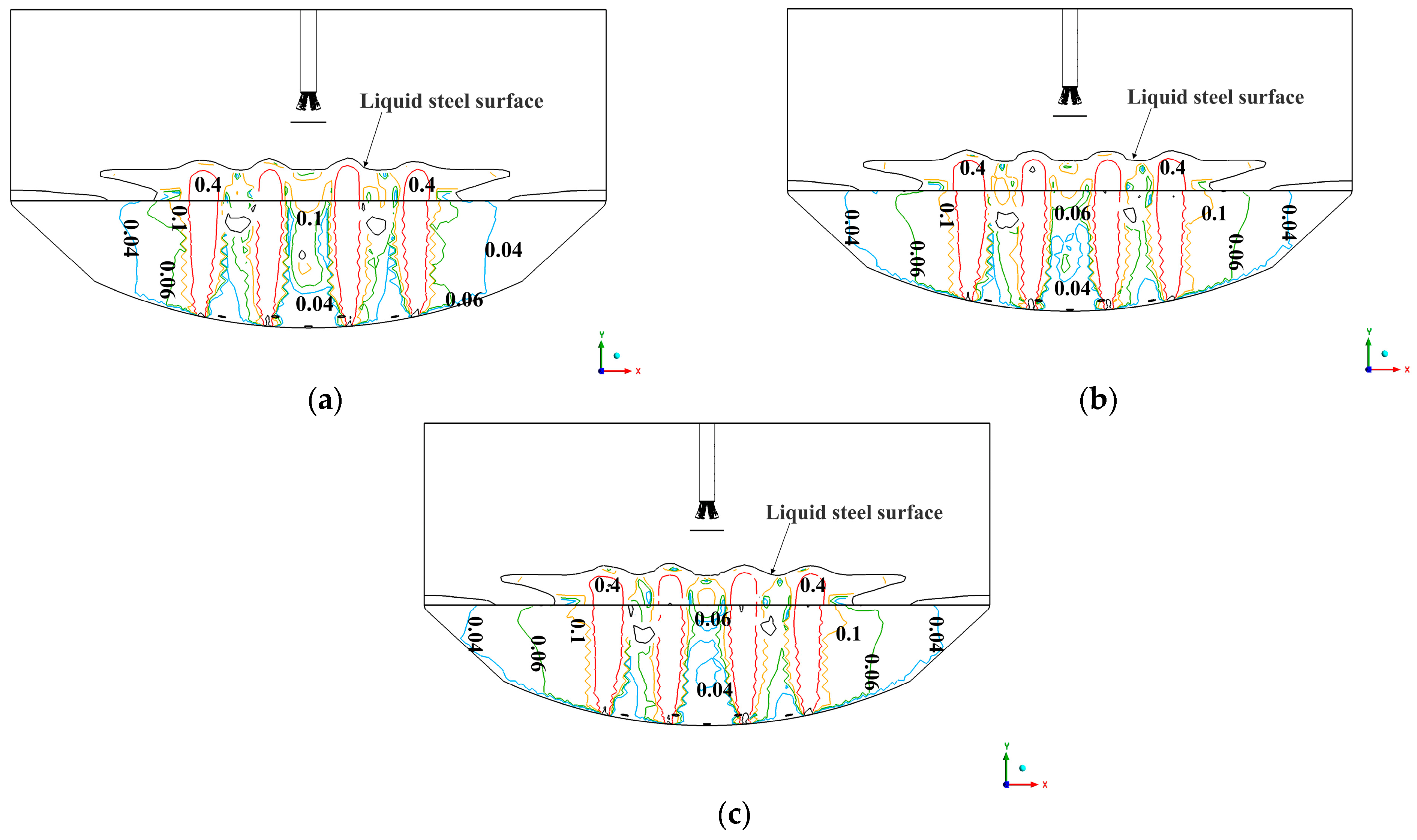

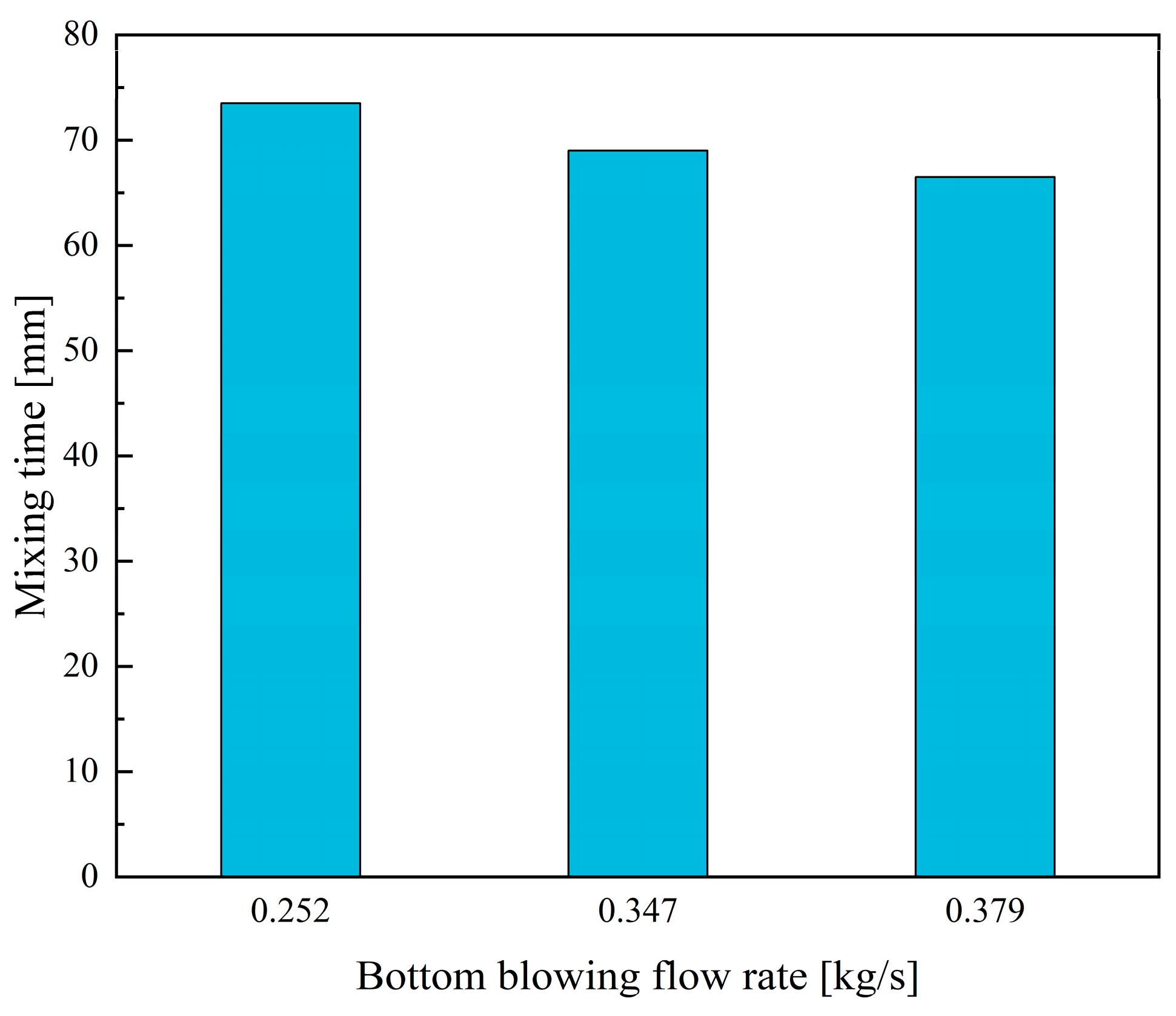


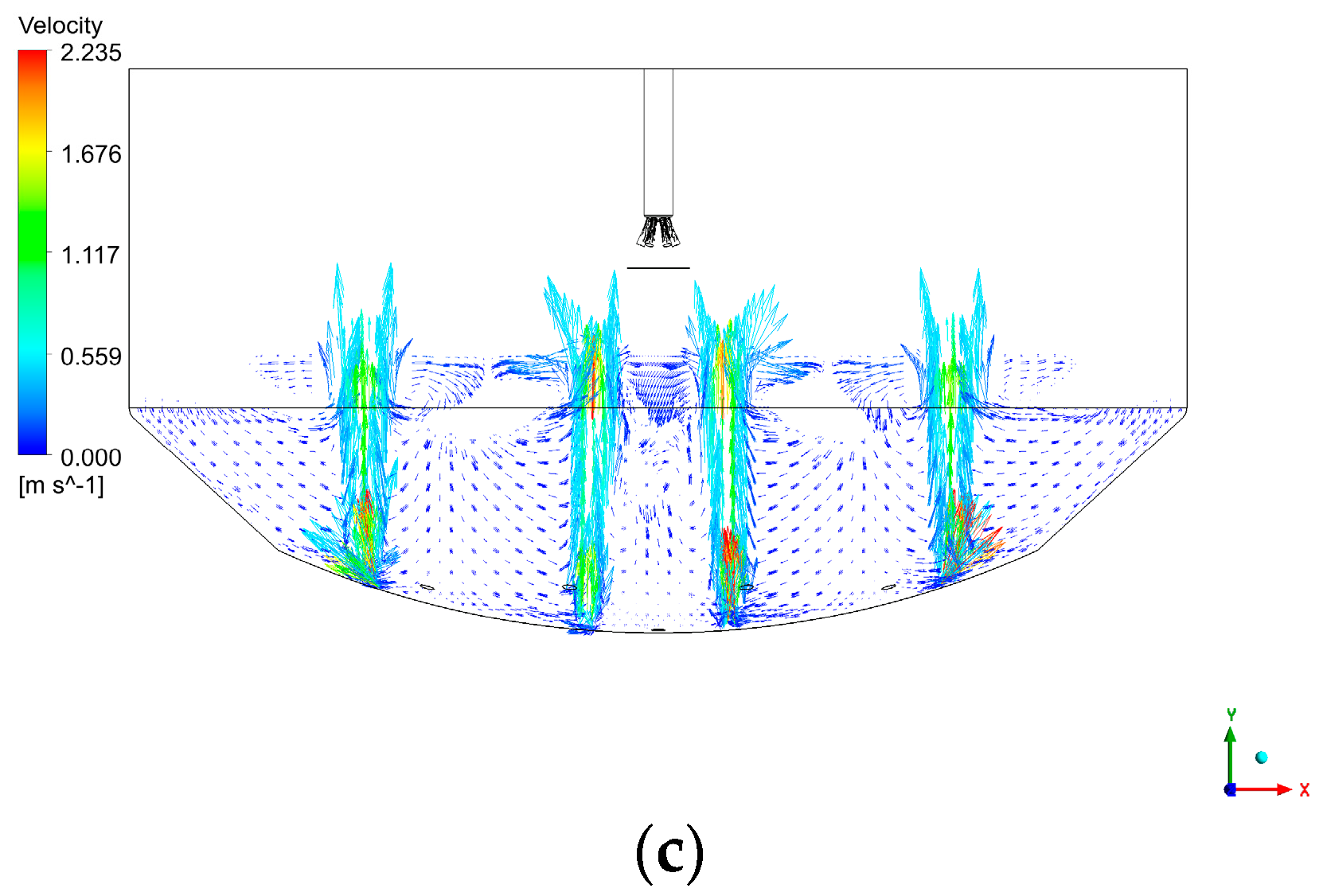
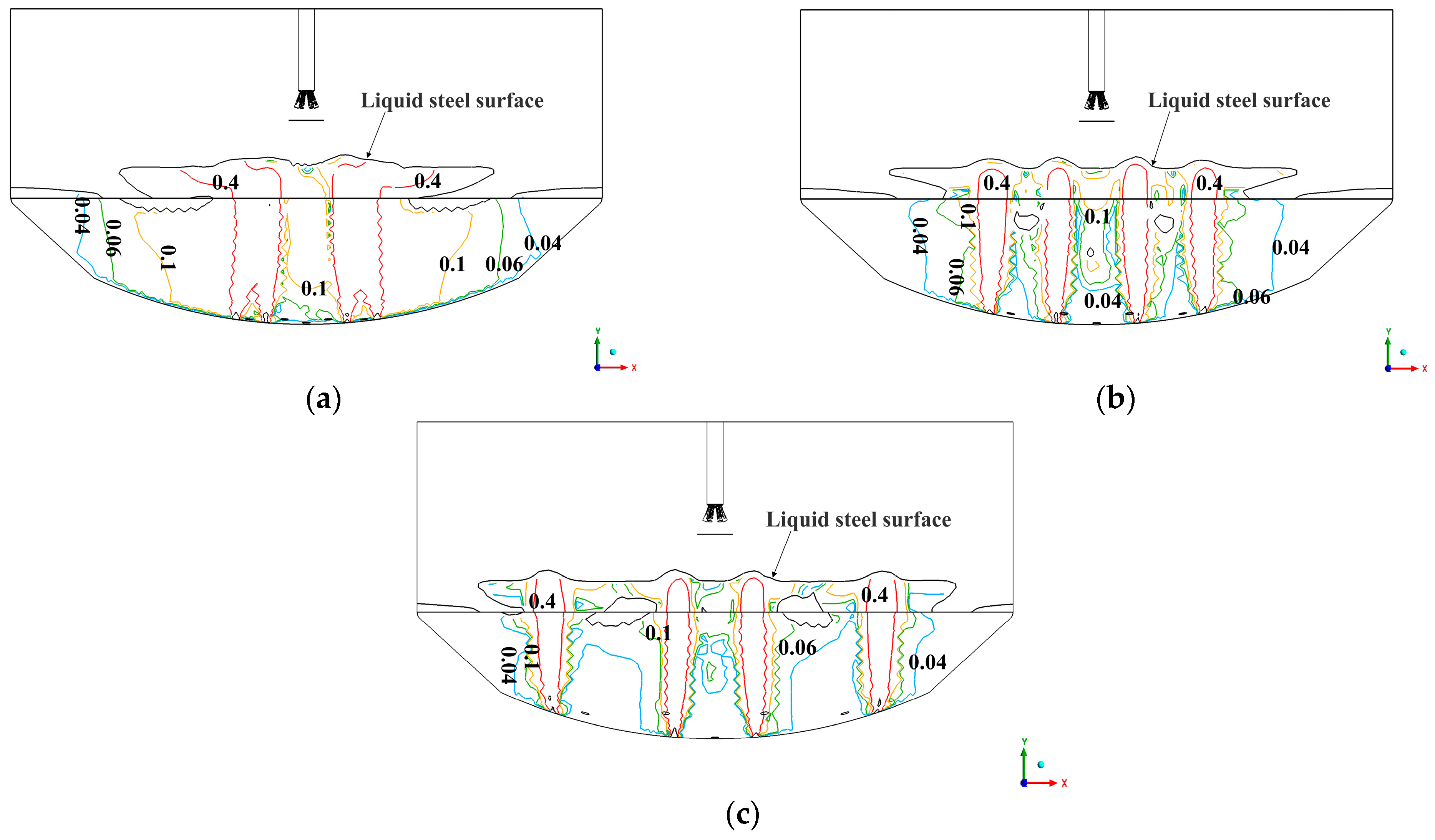

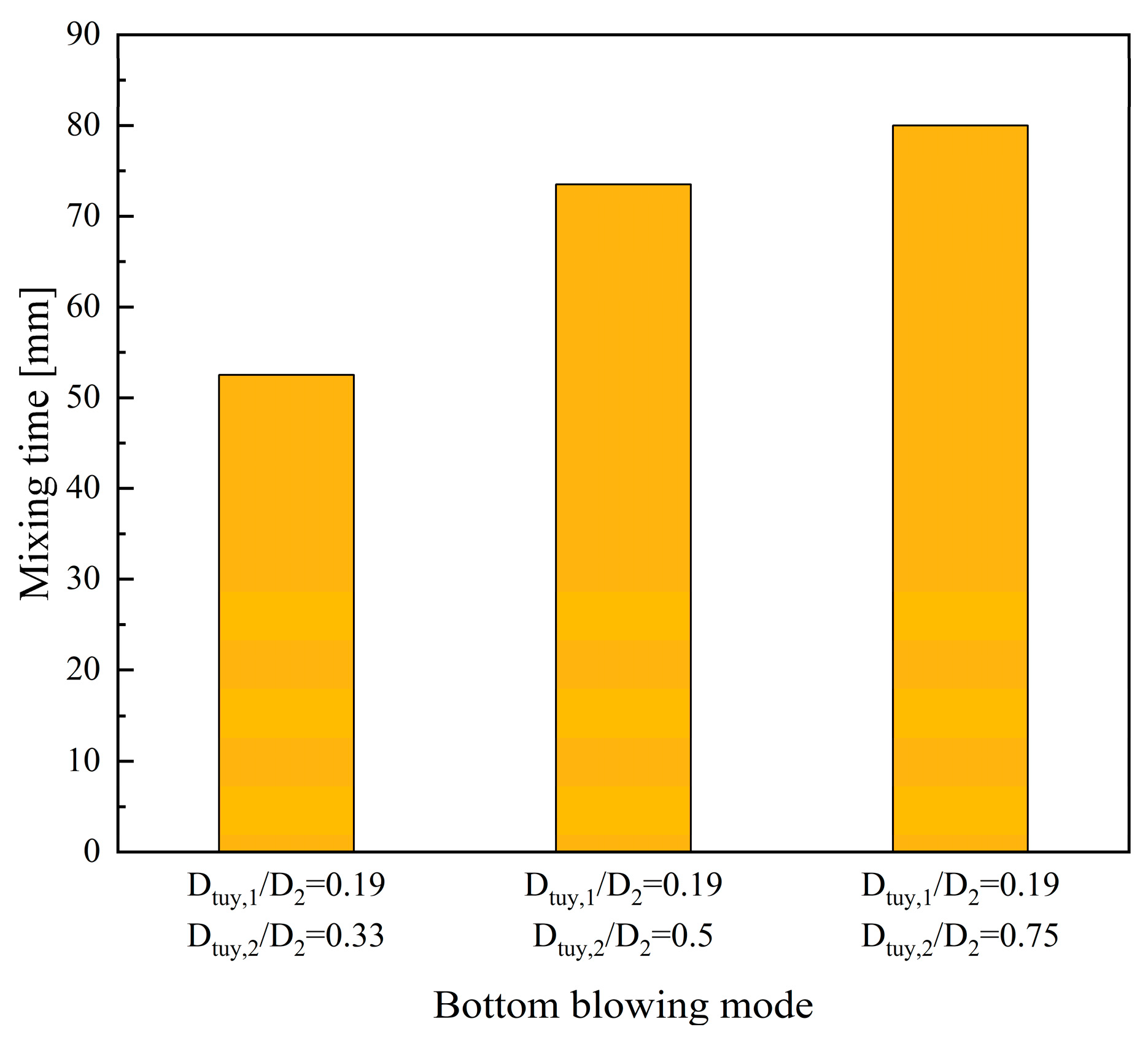
| Geometric Parameters of the Converter | Unit | Numerical Value |
|---|---|---|
| BOF nominal capacity(m) | t | 335 |
| cavity (V) | m3 | 48.3 |
| computational domain height (H) | m | 3.954 |
| average furnace diameter (D1) | m | 7.41 |
| average bottom diameter (D2) | m | 5.32 |
| lance height (Htl) | m | 1.00 |
| molten depth (Hm) | m | 1.65 |
| slag layer thickness (Hsl) | m | 0.26 |
| Physical Parameters | Unit | Argon | Molten Steel | Slag |
|---|---|---|---|---|
| density (ρ) | kg/m3 | 1.6228 | 6940 | 3490 |
| dynamic viscosity (μ) | kg/(m∙s) | 2.125 × 10−5 | 5.100 × 10−3 | 1.000 × 10−1 |
| surface tension coefficient (σ) | N/m | - | 1.54 | 1.54 |
| thermal conductivity (λ) | W/(m∙k) | 0.016 | 40 | 1.7 |
| Bottom Tuyeres Layout | Top Gas Flowrate (m3/h) | Bottom Gas Flowrate (m3/h) | Lance Height (mm) | Nozzle Angle (°) | |
|---|---|---|---|---|---|
| case 1 | 0.51 D | 77.15 | 0.209 | 104 | 15 |
| case 2 | 0.51 D | 80.52 | 0.261 | 133 | 15 |
| case 3 | 0.65 D | 70.45 | 0.157 | 104 | 15 |
Disclaimer/Publisher’s Note: The statements, opinions and data contained in all publications are solely those of the individual author(s) and contributor(s) and not of MDPI and/or the editor(s). MDPI and/or the editor(s) disclaim responsibility for any injury to people or property resulting from any ideas, methods, instructions or products referred to in the content. |
© 2023 by the authors. Licensee MDPI, Basel, Switzerland. This article is an open access article distributed under the terms and conditions of the Creative Commons Attribution (CC BY) license (https://creativecommons.org/licenses/by/4.0/).
Share and Cite
Qi, F.; Zhou, S.; Zhang, L.; Liu, Z.; Cheung, S.C.P.; Li, B. Numerical Study on Interfacial Structure and Mixing Characteristics in Converter Based on CLSVOF Method. Metals 2023, 13, 880. https://doi.org/10.3390/met13050880
Qi F, Zhou S, Zhang L, Liu Z, Cheung SCP, Li B. Numerical Study on Interfacial Structure and Mixing Characteristics in Converter Based on CLSVOF Method. Metals. 2023; 13(5):880. https://doi.org/10.3390/met13050880
Chicago/Turabian StyleQi, Fengsheng, Shuqi Zhou, Liangyu Zhang, Zhongqiu Liu, Sherman C. P. Cheung, and Baokuan Li. 2023. "Numerical Study on Interfacial Structure and Mixing Characteristics in Converter Based on CLSVOF Method" Metals 13, no. 5: 880. https://doi.org/10.3390/met13050880
APA StyleQi, F., Zhou, S., Zhang, L., Liu, Z., Cheung, S. C. P., & Li, B. (2023). Numerical Study on Interfacial Structure and Mixing Characteristics in Converter Based on CLSVOF Method. Metals, 13(5), 880. https://doi.org/10.3390/met13050880







